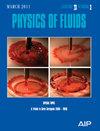Overlapping effect of detonation driving during multi-point initiation
IF 4.3
2区 工程技术
Q1 MECHANICS
引用次数: 0
Abstract
Employing multi-point initiation in warhead structures produces a detonation wave aiming warhead. Numerous studies have concentrated on enhancing the velocity and analyzing its distribution in this type of warhead. Researchers have developed formulas for the velocity distribution of asymmetrically one-line initiated warheads; however, a reliable and complete calculation method for the velocity distribution in asymmetrically two-line initiated warheads is yet to be established. A new idea is proposed and verified in this work: the velocity distribution for the asymmetric two-line initiation can be derived from that of the one-line initiation. Initial efforts include conducting experimentally verified numerical modeling to examine the propagation and interaction of detonation waves in asymmetrically two-line initiated warheads. Subsequently, using the principle of independent propagation, a model is formulated to use the velocity distribution from asymmetric one-line initiation to predict that of asymmetric two-line initiations. Finally, arena tests are performed to corroborate the overlapping model. This research can provide valuable insights for lethality assessment, protection design, and security analysis.多点起爆期间起爆驱动的重叠效应
在弹头结构中采用多点起爆会产生一个起爆波瞄准弹头。大量研究集中于提高这类弹头的速度并分析其分布。研究人员已经建立了非对称单线起爆弹头的速度分布公式,但对于非对称双线起爆弹头的速度分布,尚未建立可靠而完整的计算方法。本研究提出并验证了一个新想法:非对称双线起爆弹头的速度分布可以从单线起爆弹头的速度分布推导出来。最初的工作包括进行经过实验验证的数值建模,以研究非对称双线起爆弹头中引爆波的传播和相互作用。随后,利用独立传播原理,建立了一个模型,利用非对称单线起爆的速度分布来预测非对称双线起爆的速度分布。最后,进行了竞技场试验,以证实重叠模型。这项研究可为致命性评估、防护设计和安全分析提供有价值的见解。
本文章由计算机程序翻译,如有差异,请以英文原文为准。
求助全文
约1分钟内获得全文
求助全文
来源期刊

Physics of Fluids
物理-力学
CiteScore
6.50
自引率
41.30%
发文量
2063
审稿时长
2.6 months
期刊介绍:
Physics of Fluids (PoF) is a preeminent journal devoted to publishing original theoretical, computational, and experimental contributions to the understanding of the dynamics of gases, liquids, and complex or multiphase fluids. Topics published in PoF are diverse and reflect the most important subjects in fluid dynamics, including, but not limited to:
-Acoustics
-Aerospace and aeronautical flow
-Astrophysical flow
-Biofluid mechanics
-Cavitation and cavitating flows
-Combustion flows
-Complex fluids
-Compressible flow
-Computational fluid dynamics
-Contact lines
-Continuum mechanics
-Convection
-Cryogenic flow
-Droplets
-Electrical and magnetic effects in fluid flow
-Foam, bubble, and film mechanics
-Flow control
-Flow instability and transition
-Flow orientation and anisotropy
-Flows with other transport phenomena
-Flows with complex boundary conditions
-Flow visualization
-Fluid mechanics
-Fluid physical properties
-Fluid–structure interactions
-Free surface flows
-Geophysical flow
-Interfacial flow
-Knudsen flow
-Laminar flow
-Liquid crystals
-Mathematics of fluids
-Micro- and nanofluid mechanics
-Mixing
-Molecular theory
-Nanofluidics
-Particulate, multiphase, and granular flow
-Processing flows
-Relativistic fluid mechanics
-Rotating flows
-Shock wave phenomena
-Soft matter
-Stratified flows
-Supercritical fluids
-Superfluidity
-Thermodynamics of flow systems
-Transonic flow
-Turbulent flow
-Viscous and non-Newtonian flow
-Viscoelasticity
-Vortex dynamics
-Waves
 求助内容:
求助内容: 应助结果提醒方式:
应助结果提醒方式:


